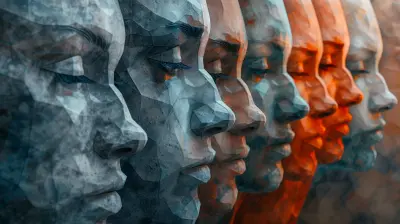The Healing Potential of Dance Movement Therapy for Emotional Expression
5 July 2025
Emotions are a fundamental part of being human. Yet, sometimes, words alone aren't enough to express what we feel. Have you ever found yourself dancing when overwhelmed with emotions—whether it’s joy, sadness, or frustration? That’s because movement can serve as a powerful outlet for emotional expression. This is where Dance Movement Therapy (DMT) comes in.
DMT is more than just dancing—it’s a therapeutic approach that helps individuals process, express, and heal through movement. But how does this really work? And why is it such an effective way to navigate emotional struggles? Let’s dive deep into how dance movement therapy holds the potential to unlock emotional healing. 
What Is Dance Movement Therapy?
A Blend of Dance and Psychology
Dance Movement Therapy (DMT) is a psychotherapeutic approach that uses movement to support emotional, cognitive, physical, and social well-being. Unlike traditional therapy, which relies heavily on verbal communication, DMT taps into the body’s natural ability to express emotions through movement.It was pioneered by Marian Chace, a dancer and psychotherapist, in the 1940s. She observed how movement allowed people to connect with their emotions and communicate what words couldn’t. Today, DMT is widely used across various settings, from clinical mental health care to wellness programs. 
How Dance Movement Therapy Helps with Emotional Expression
1. Breaking Through Verbal Barriers
Sometimes, talking about emotions is difficult. Whether due to trauma, anxiety, or simply not having the right words, verbal expression can feel limiting. Dance movement therapy creates a safe space where individuals can express themselves freely without needing to say a single word.Imagine emotions as a bottled-up storm. Movement acts as the release valve, allowing those feelings to flow in a natural, unrestricted way.
2. Connecting the Mind and Body
Our emotions don’t just exist in our minds; they are deeply connected to our bodies. Stress, trauma, grief—these emotions often manifest physically, leading to tension, fatigue, or even illness. DMT encourages a deeper mind-body connection, helping individuals tune in to what their bodies are communicating.By moving in a way that mirrors inner emotions, a person can gain insight into their feelings and begin the healing process through bodily awareness.
3. Releasing Stored Trauma
The body holds onto past traumatic experiences, often locking them away in muscle tension, posture, or breathing patterns. This is known as somatic memory—the idea that our physical body remembers emotional pain even when our conscious mind does not.DMT helps release these stored emotions in a safe and controlled environment. Through guided movement and rhythmic exercises, individuals can slowly let go of past traumas, making way for emotional relief and healing.
4. Enhancing Emotional Regulation
For those struggling with overwhelming emotions—such as anxiety, depression, or anger—DMT offers a structured way to process and regulate feelings. Movement allows individuals to channel their emotions in a productive way, rather than suppressing or avoiding them.For example, someone experiencing intense anxiety might engage in controlled breathing and fluid movements to promote relaxation. On the other hand, an individual dealing with suppressed anger might benefit from dynamic, powerful movements to release tension. 
The Science Behind Dance Movement Therapy
You might be wondering, Is there actual science to back this up? Absolutely! Research shows that physical movement directly impacts mental and emotional well-being. Here’s how:- Boosts Endorphins: Movement stimulates the release of endorphins, the body’s natural “feel-good” chemicals, which help reduce stress and improve mood.
- Activates the Limbic System: This is the part of the brain responsible for emotions and memory. Engaging in movement strengthens emotional processing pathways.
- Enhances Neuroplasticity: Regular movement therapy encourages new neural connections, helping the brain adapt and heal from past emotional wounds.
- Regulates Cortisol Levels: Dance movement therapy can lower cortisol (the stress hormone), helping individuals feel more balanced and calm. 
Who Can Benefit from Dance Movement Therapy?
The beauty of DMT is that it’s for everyone. You don’t need to be a dancer or have any prior experience with movement. It’s an inclusive, accessible form of therapy that can benefit:- Individuals experiencing anxiety, depression, or PTSD
- Survivors of trauma or abuse
- Children with developmental or emotional difficulties
- People struggling with body image issues
- Individuals going through major life transitions (grief, loss, divorce, etc.)
- Those simply looking for a deeper emotional connection with themselves
Movement has no limitations—it meets you exactly where you are.
Types of Movements Used in Dance Movement Therapy
DMT sessions are often tailored to each individual’s needs. However, some common movement techniques include:1. Mirroring
This involves a therapist or participant mirroring another person’s movements, creating a sense of connection and empathy. Mirroring helps individuals feel recognized and understood, which is essential for emotional healing.2. Breath-Connected Movement
Breath work is an essential part of emotional regulation. Integrating movement with deep, intentional breathing helps release tension and center the mind.3. Improvisation & Free Movement
In this form of DMT, individuals let go of structured movement and allow their bodies to flow naturally. This encourages authentic self-expression without judgment.4. Rhythmic Movement & Patterning
Engaging in repetitive, rhythmic movements can be especially soothing. Think of it like rocking a baby—rhythm has an innate ability to calm the nervous system and provide emotional stability.How to Incorporate Dance Movement Therapy Into Your Life
You don’t need to attend formal therapy sessions to experience the benefits of DMT. Here are a few ways you can integrate movement-based emotional expression into your daily routine:- Put on music and dance freely when you're feeling overwhelmed. Let your body guide you.
- Try mindful movement exercises, such as tai chi or yoga, to engage in body awareness.
- Use movement to release tension—punch a pillow, stomp your feet, or shake out emotional stress.
- Engage in rhythmic breathing and stretching to center yourself.
- Join a dance class—even if it’s just for fun, movement in a group setting can be deeply therapeutic.
The most important thing? Let go of self-judgment and allow yourself to move without fear. Your body already knows how to express what words cannot.
Final Thoughts
Dance Movement Therapy is a testament to the power of movement as medicine. In a world where we often suppress emotions, DMT provides an alternative path to healing—one that doesn’t rely solely on words but instead taps into the body’s innate wisdom.Emotional expression isn’t just about talking—it’s about feeling, moving, and releasing. Whether through structured therapy or spontaneous dance in your living room, movement has the power to heal, transform, and reconnect you with yourself.
So the next time you feel emotionally stuck, try moving through it. Your body might just hold the key to the healing you've been looking for.
all images in this post were generated using AI tools
Category:
Therapy TechniquesAuthor:

Janet Conrad
Discussion
rate this article
1 comments
Ryan Kim
Beautifully expressed, thank you!
July 27, 2025 at 5:01 PM

Janet Conrad
Thank you so much! I'm glad you resonated with it.


